500 Freshwater Aquarium Fish: A Visible Reference to the Most In style Species
Praise for the hardcover edition:
“For users looking for specific information on freshwater aquarium fish this will be a useful and interesting resource.”
–American Reference Books Annual 2007
“Any home or library collection strong in aquarium references — and many a fish store — will find this packed with in-depth detail perfect for setting up an aquarium.”
–The Midwest Book Review
This comprehensive full-color reference covers 500 of the most popular freshwater aquarium fish. It provides concise at-a-glance information on their behavior, diet and breeding along with guidance and recommendations on setting up a freshwater aquarium.
Substantive and well organized for easy navigation, the book satisfies a wide of needs. Beginners can start their hobby with confidence and experienced keepers can use the book as an authoritative reference.
The most important update of this edition is that species names have been changed in accordance with the latest international revisions, made to take into account recent DNA information. In all, about 120 names are updated.
Freshwater Aquarium Fish is a “window shopping” trip guided by an aquarium specialist ready to offer advice. The directory details every species appropriate for a freshwater aquarium. While most require a heated aquarium, other varieties can be kept in an unheated one (such as bloodfin tetras, white clouds and the beginner classic, goldfish).
The book organizes the freshwater aquarium species in major groups, among them: Cichlids (such as angelfish and discus); Catfish; Cyprinids (such as barbs, danios, koi and goldfish); Characoids (such as tetras, neons and piranhas); Loaches and suckers; Gouramis (such as bettas, paradise fish and snakeheads); Rainbow fish and blue-eyes; and Livebearers (such as mollies and platies).
This comprehensive and useful reference is from a highly respected fish keeper with more than 50 years’ experience. His advice and guidance will be welcomed by amateur fish keepers of any age and expertise.
From the Publisher
500 Freshwater Aquarium Fish: A Visual Reference to the Most Popular Species

THERE ARE WELL OVER 24,000 SPECIES OF FISH known to science, and that number appears to be increasing daily. With so many thousands of species in existence—from whale sharks to minnows—we should all know what a fish is. However, things are not that simple, since there is no categorical definition of the term “fish.”
Identifying combined characteristics associated with fishes, such as an aquatic lifestyle and the possession of gills and fins, might seem to bring a definition a little closer— but other animals such as cuttlefishes (Sepia, etc.) and squids exhibit the same characteristics.
In broad terms there are two groups of fishes:
Cartilaginous fishes (Class Chondrichthyes): Sharks, rays, and chimaeras (about 700 species).
Bony fishes (Class Osteichthyes): A large class of species ranging from guppies to seahorses (over 23,000 species).
Of these two categories, the one that is encountered almost (but not quite) exclusively in aquaria and in ponds is the Class Osteichthyes, the bony fishes. It is possible, with difficulty and numerous exceptions and qualifications, to list the characteristics that, in combination, allow us to recognize a bony fish as such.
Bony fish:
• Possess a braincase and limb (fin) skeleton consisting, at least in part, of bone.
• Possess fins, usually with spines and/or rays.
• Breathe through outwardly directed gills covered by an operculum (gill cover) that appears externally as a slit-like aperture.
• Have bodies totally or partially covered in scales (with some important exceptions).
• Possess an air/gas swim-bladder used in buoyancy control (with a few exceptions).
• Possess a sensory mechanism called the lateral line system, which runs in a head–tail direction.
• Are poikilothermic (cold-blooded): their body temperature is determined by that of the environment.



Bandit Corydoras (Corydoras metae)
This pink and black corydoras has a black “mask” that extends from the top of the head, through the eye, to the bottom edge of the gill covers— hence the “Bandit” part of the name. The front of the dorsal fin is also black, this pigmentation running in a single central band along the back to the top front edge of the caudal fin and then down to the bottom front edge of the fin. From the side it can easily be confused with C. melini (Diagonal Stripe, or False Bandit, Corydoras) from the state of Amazonas in Brazil. However, from above the single black dorsal band of the Bandit Corydoras splits into two separate narrower bands in C. melini; they extend diagonally toward the caudal peduncle (the base of the tail fin).
Black-belt Cichlid (Vieja maculicauda)
The Black-belt Cichlid is an old favorite. It is easily distinguished by its prominent vertical central-body band, from which the common name derives. This band runs from the center of the dorsal fin right down to the belly, although its breadth and sharpness vary from specimen to specimen and according to the individual’s mood.
Fenestratus (Protomelas fenestratus)
Also known in the trade as Haplochromis steveni “Thick Bars,” this is one of several Protomelas species available, some of which are still awaiting scientific description. Male Fenestratus are the more brightly colored of the sexes, with the females having a more inconspicuous gray to silver coloration.



African Buffalohead (Steatocranus casuarius)
All the common names of this species—which is the only Steatocranus frequently seen in the hobby—accurately describe the head shape of fully mature males. Females also possess the nuchal (head) hump, but it is much less pronounced than in males. Steatocranus is a bottom dweller with limited swimming ability.
Green Terror (Andinoacara rivulatus)
This relatively large fish has distinctive cheek markings that are similar to those found in the Blue Acara. However, the head, particularly in males, is considerably larger, with a noticeable “forehead.” The Gold Saum and Silver Saum have golden/reddish and whitish/silvery edges to the dorsal and caudal fins respectively.
Orange-finned Loach (Yasuhikotakia modesta)
This is an unusually, but most attractively, colored species. It is sometimes confused with B. lecontei (Leconte’s Loach). However, in Orange-finned Loach all the fins are orange to yellow, while in B. lecontei the dorsal fin is grayish blue.
Publisher : Firefly Books; Updated edition (June 1, 2018)
Language : English
Paperback : 528 pages
ISBN-10 : 1770859195
ISBN-13 : 978-1770859197
Item Weight : 1.85 pounds
Dimensions : 6 x 0.13 x 6.25 inches
$20.92
Worth: $20.92
(as of Oct 24, 2023 16:38:13 UTC – Particulars)
Reward for the hardcover version:
“For customers in search of particular data on freshwater aquarium fish this might be a helpful and attention-grabbing useful resource.”
–American Reference Books Annual 2007
“Any dwelling or library assortment sturdy in aquarium references — and lots of a fish retailer — will discover this full of in-depth element good for organising an aquarium.”
–The Midwest Guide Evaluation
This complete full-color reference covers 500 of the most well-liked freshwater aquarium fish. It supplies concise at-a-glance data on their conduct, weight loss program and breeding together with steering and suggestions on organising a freshwater aquarium.
Substantive and nicely organized for straightforward navigation, the e-book satisfies a large of wants. Inexperienced persons can begin their passion with confidence and skilled keepers can use the e-book as an authoritative reference.
An important replace of this version is that species names have been modified in accordance with the most recent worldwide revisions, made to keep in mind current DNA data. In all, about 120 names are up to date.
Freshwater Aquarium Fish is a “window buying” journey guided by an aquarium specialist prepared to supply recommendation. The listing particulars each species acceptable for a freshwater aquarium. Whereas most require a heated aquarium, different varieties might be saved in an unheated one (akin to bloodfin tetras, white clouds and the newbie basic, goldfish).
The e-book organizes the freshwater aquarium species in main teams, amongst them: Cichlids (akin to angelfish and discus); Catfish; Cyprinids (akin to barbs, danios, koi and goldfish); Characoids (akin to tetras, neons and piranhas); Loaches and suckers; Gouramis (akin to bettas, paradise fish and snakeheads); Rainbow fish and blue-eyes; and Livebearers (akin to mollies and platies).
This complete and helpful reference is from a extremely revered fish keeper with greater than 50 years’ expertise. His recommendation and steering might be welcomed by newbie fish keepers of any age and experience.
From the Writer
500 Freshwater Aquarium Fish: A Visible Reference to the Most In style Species
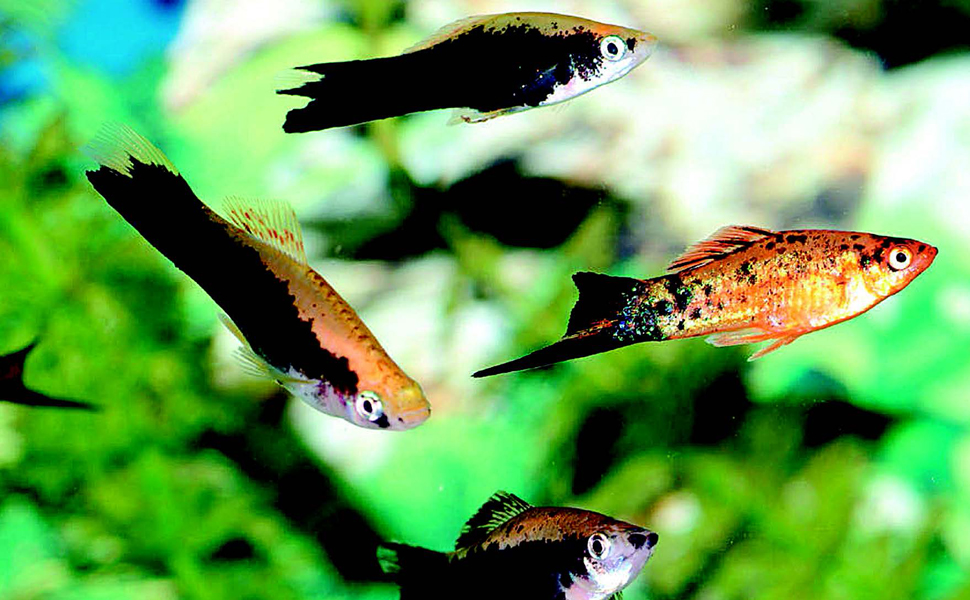
THERE ARE WELL OVER 24,000 SPECIES OF FISH recognized to science, and that quantity seems to be rising day by day. With so many 1000’s of species in existence—from whale sharks to minnows—we must always all know what a fish is. Nevertheless, issues usually are not that easy, since there is no such thing as a categorical definition of the time period “fish.”
Figuring out mixed traits related to fishes, akin to an aquatic way of life and the possession of gills and fins, may appear to convey a definition a little bit nearer— however different animals akin to cuttlefishes (Sepia, and so on.) and squids exhibit the identical traits.
In broad phrases there are two teams of fishes:
Cartilaginous fishes (Class Chondrichthyes): Sharks, rays, and chimaeras (about 700 species).
Bony fishes (Class Osteichthyes): A big class of species starting from guppies to seahorses (over 23,000 species).
Of those two classes, the one that’s encountered virtually (however not fairly) completely in aquaria and in ponds is the Class Osteichthyes, the bony fishes. It’s potential, with problem and quite a few exceptions and {qualifications}, to checklist the traits that, together, permit us to acknowledge a bony fish as such.
Bony fish:
• Possess a braincase and limb (fin) skeleton consisting, not less than partially, of bone.
• Possess fins, often with spines and/or rays.
• Breathe by outwardly directed gills coated by an operculum (gill cowl) that seems externally as a slit-like aperture.
• Have our bodies completely or partially coated in scales (with some vital exceptions).
• Possess an air/gasoline swim-bladder utilized in buoyancy management (with a couple of exceptions).
• Possess a sensory mechanism known as the lateral line system, which runs in a head–tail route.
• Are poikilothermic (cold-blooded): their physique temperature is set by that of the atmosphere.
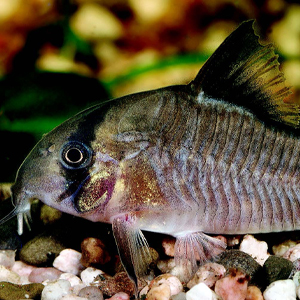
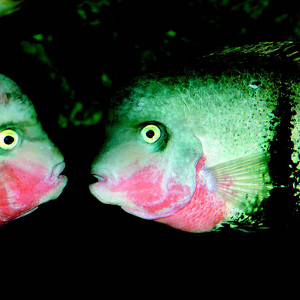
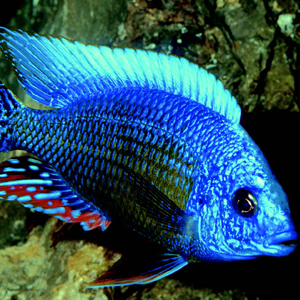
Bandit Corydoras (Corydoras metae)
This pink and black corydoras has a black “masks” that extends from the highest of the pinnacle, by the attention, to the underside fringe of the gill covers— therefore the “Bandit” a part of the title. The entrance of the dorsal fin can also be black, this pigmentation working in a single central band alongside the again to the highest entrance fringe of the caudal fin after which right down to the underside entrance fringe of the fin. From the facet it might simply be confused with C. melini (Diagonal Stripe, or False Bandit, Corydoras) from the state of Amazonas in Brazil. Nevertheless, from above the one black dorsal band of the Bandit Corydoras splits into two separate narrower bands in C. melini; they lengthen diagonally towards the caudal peduncle (the bottom of the tail fin).
Black-belt Cichlid (Vieja maculicauda)
The Black-belt Cichlid is an outdated favourite. It’s simply distinguished by its outstanding vertical central-body band, from which the frequent title derives. This band runs from the middle of the dorsal fin proper right down to the stomach, though its breadth and sharpness range from specimen to specimen and based on the person’s temper.
Fenestratus (Protomelas fenestratus)
Additionally recognized within the commerce as Haplochromis steveni “Thick Bars,” that is one in every of a number of Protomelas species out there, a few of that are nonetheless awaiting scientific description. Male Fenestratus are the extra brightly coloured of the sexes, with the females having a extra inconspicuous grey to silver coloration.
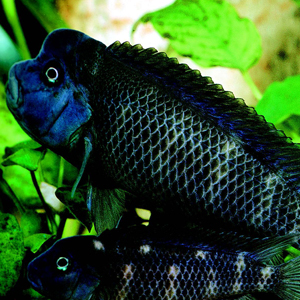
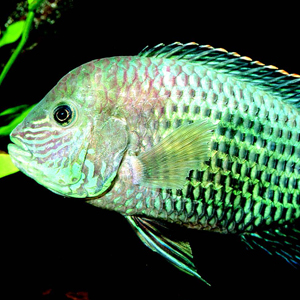
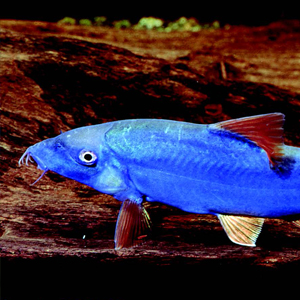
African Buffalohead (Steatocranus casuarius)
All of the frequent names of this species—which is the one Steatocranus regularly seen within the passion—precisely describe the pinnacle form of absolutely mature males. Females additionally possess the nuchal (head) hump, however it’s a lot much less pronounced than in males. Steatocranus is a backside dweller with restricted swimming capability.
Inexperienced Terror (Andinoacara rivulatus)
This comparatively massive fish has distinctive cheek markings which might be just like these discovered within the Blue Acara. Nevertheless, the pinnacle, notably in males, is significantly bigger, with a noticeable “brow.” The Gold Saum and Silver Saum have golden/reddish and whitish/silvery edges to the dorsal and caudal fins respectively.
Orange-finned Loach (Yasuhikotakia modesta)
That is an unusually, however most attractively, coloured species. It’s typically confused with B. lecontei (Leconte’s Loach). Nevertheless, in Orange-finned Loach all of the fins are orange to yellow, whereas in B. lecontei the dorsal fin is grayish blue.
Writer : Firefly Books; Up to date version (June 1, 2018)
Language : English
Paperback : 528 pages
ISBN-10 : 1770859195
ISBN-13 : 978-1770859197
Merchandise Weight : 1.85 kilos
Dimensions : 6 x 0.13 x 6.25 inches
User Reviews
Be the first to review “500 Freshwater Aquarium Fish: A Visible Reference to the Most In style Species”
You must be logged in to post a review.
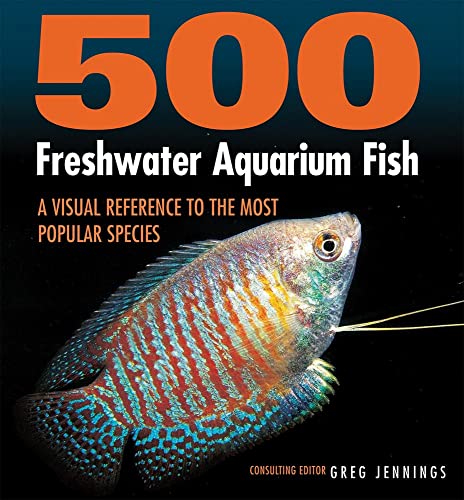
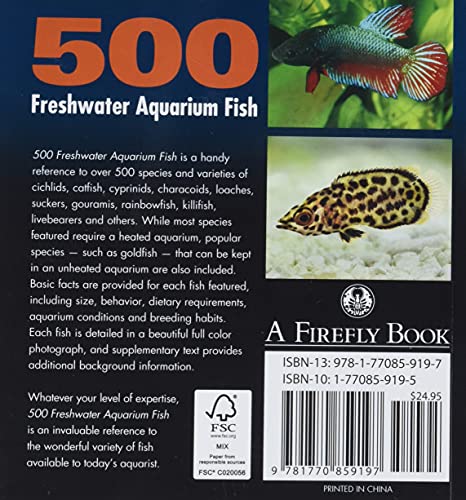
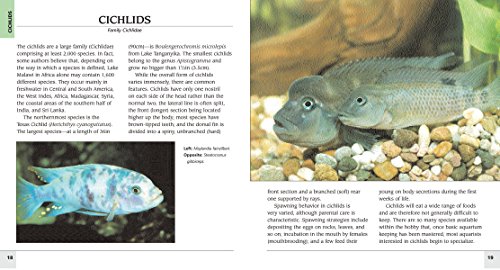
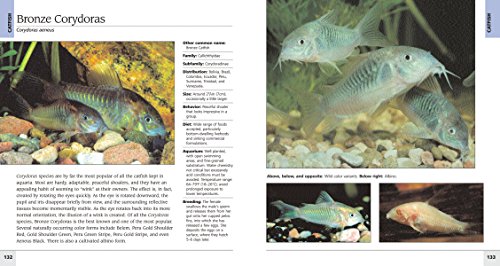
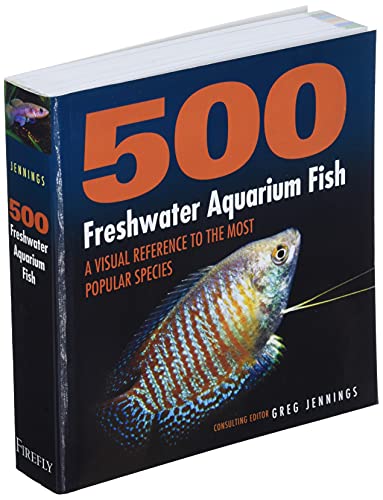
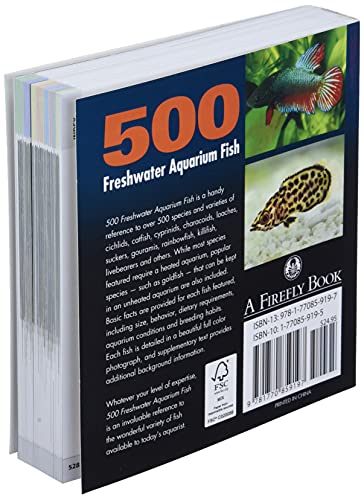



There are no reviews yet.